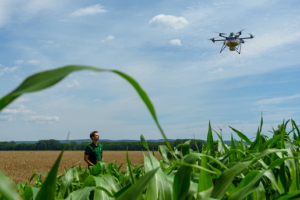The application of trichogramma (ichneumon flies) using drones has already become established as an effective way of protecting maize from the corn borer. This season, we were again able to fly over more than 4,200 hectares of corn with our hexacopters. The enormous time savings and the profound knowledge about the ideal application time make this service a success story for Lagerhaus.

As in previous years, we were very successful with the production of the so-called trichogramma with the help of our hexacopters in Burgenland, Lower Austria and Upper Austria. This biologically tested procedure neither results in pests developing any resistance nor poses any danger to bees, soil and groundwater.
With a flight performance of about four minutes per hectare, we are able to apply the ichneumon flies packed in balls with precision and speed. These balls contain ichneumon flies in different stages of development, which hatch within two weeks and lay their eggs in the corn borer larvae. After two weeks, a second application takes place. This ensures that the corn borer is parasitized within a period of one month.
Arguments for combating the corn borer
– Regulating the population of the corn borer pest
– Securing and increasing the maize yield
– Ensuring the quality of the maize
– Preventing boreholes, which are entry points for fungi and increase the risk of mycotoxins in the corn
– Protecting succeeding crops, reducing fungal diseases and improving soil hygiene
– Reducing and limiting the population of corn borer in the following year
Application Engineering
– Biological and environmentally-friendly process
– Simple and fast application
– Balls of rotting corn starch or cellulose
– Grain maize/seed maize: two releases with ichneumon flies at intervals of 10-14 days (2 x 100 balls/ha) recommended
– Sweetcorn: three releases
Photo: RWA
